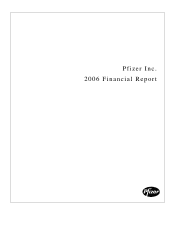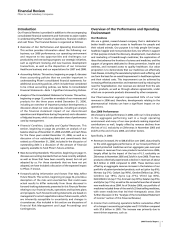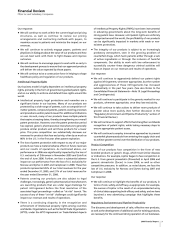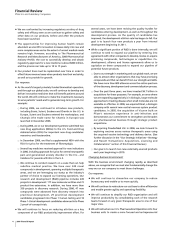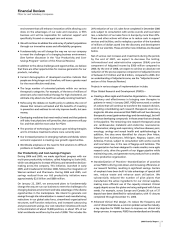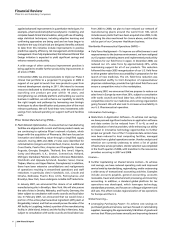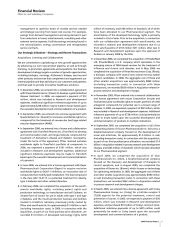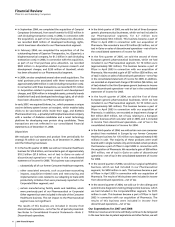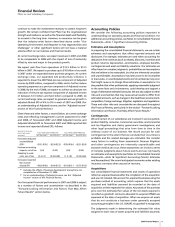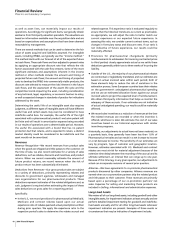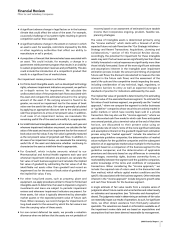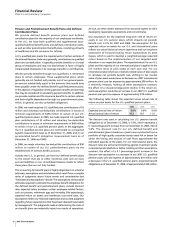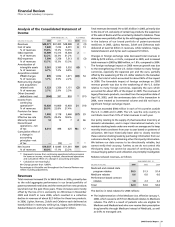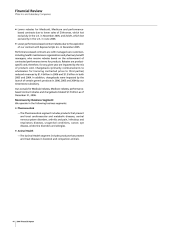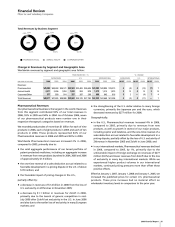Pfizer 2006 Annual Report Download - page 7
Download and view the complete annual report
Please find page 7 of the 2006 Pfizer annual report below. You can navigate through the pages in the report by either clicking on the pages listed below, or by using the keyword search tool below to find specific information within the annual report.
environment that will enhance innovation while allowing us to
draw on the advantages of our scale and resources. A fifth
business unit will be responsible for customer support and
specifically focused on managed care and access.
•
We will continue to address the wide array of patient populations
through our innovative access and affordability programs.
•
Fundamentally, we will change the way we run our company
to meet the challenges of a changing business environment.
(See further discussion in the “Our Productivity and Cost-
Savings Program” section of this Financial Review.)
In addition to the above challenges and opportunities, we believe
that there are other opportunities for revenue generation for our
products, including:
•
Current demographics of developed countries indicate that
people are living longer and, therefore, will have a greater need
for the most effective medicines.
•
The large number of untreated patients within our various
therapeutic categories. For example, of the tens of millions of
Americans who need medical therapy for high cholesterol, we
estimate only about one-fourth are actually receiving treatment.
•
Refocusing the debate on health policy to address the cost of
disease that remains untreated and the benefits of investing
in prevention and wellness to not only improve health, but save
money.
•
Developing medicines that meet medical need and that patients
will take; that physicians will prescribe; that customers will pay
for; and that add the most value for Pfizer.
•
The promise of technology to improve upon existing therapies
and to introduce treatments where none currently exist.
•
Our increased presence in emerging markets worldwide, where
economic expansion is creating new growth opportunities.
•
Worldwide emphasis on the need to find solutions to difficult
problems in healthcare systems.
Our Productivity and Cost-Savings Program
During 2006 and 2005, we made significant progress with our
multi-year productivity initiative, called Adapting to Scale (AtS),
which was designed to increase efficiency and streamline decision-
making across the company. This initiative, launched in early
2005, and broadened in October 2006, follows the integration of
Warner-Lambert and Pharmacia. During 2006 and 2005, cost
savings realized from our AtS productivity initiative were
approximately $2.6 billion and $800 million.
On January 22, 2007, we announced plans to fundamentally
change the way we run our business to meet the challenges of a
changing business environment and take advantage of the diverse
opportunities in the marketplace. We intend to generate cost
savings through site rationalization in research and manufacturing,
reductions in our global sales force, streamlined organizational
structures, staff function reductions, and increased outsourcing
and procurement savings. Our cost reduction initiatives will result
in the elimination of about 10,000 positions, or about 10% of our
total worldwide workforce by the end of 2008. This includes the
20% reduction of our U.S. sales force completed in December 2006
and, subject to consultation with works councils and local labor
law, a reduction of our sales force in Europe by more than 20%.
These and other actions will allow us to reduce costs in support
services and facilities, and to redeploy a portion of the hundreds
of millions of dollars saved into the discovery and development
work of our scientists. These and other new initiatives are discussed
below.
Net of various cost increases and investments during the period,
by the end of 2007, we expect to decrease the Selling,
informational and administrative expense (SI&A) pre-tax
component of Adjusted income by $500 million compared to
2006. By the end of 2008, we expect to achieve an absolute net
reduction of the pre-tax expense component of Adjusted income
of between $1.5 billion and $2.0 billion, compared to 2006. (For
an understanding of Adjusted income, see the “Adjusted Income”
section of this Financial Review.)
Projects in various stages of implementation include:
Pfizer Global Research and Development (PGRD)—
•
Creating a More Agile and Productive Organization—To increase
efficiency and effectiveness in bringing new therapies to
patients-in-need, in January 2007, PGRD announced a number
of actions that will continue to transform the research division,
including consolidating each research therapeutic area into a
single site. We also announced that PGRD will exit two discovery
therapeutic areas (gastroenterology and dermatology), but will
continue developing compounds in those areas that are already
in the pipeline. The remaining nine research therapeutic areas
are: cardiovascular, metabolic and endocrine; neuroscience;
inflammation; allergy and respiratory; infectious diseases; pain;
oncology; urology and sexual health and ophthalmology. In
addition, five sites were identified for closure (Ann Arbor,
Esperion and Kalamazoo, Michigan; Nagoya, Japan; and
Amboise, France), subject to consultation with works councils
and local labor law, in the case of Nagoya and Amboise. This
reorganization has been designed to create smaller, more agile
research units, drive the growth of our bigger pipeline while
maintaining costs, and generate more products from a smaller,
more productive organization.
•
Standardization of Practices—Standardization of practices
across PGRD is driving costs down and increasing efficiencies in
our research facilities, resulting in significant savings. Centers
of emphasis have been built to take advantage of special skill
sets, reduce waste and enhance asset utilization. We
substantially reduced the number of pilot plants that
manufacture the active ingredients for our clinical supplies,
making more efficient use of the capacity retained. Clinical
supply depots across the globe are being realigned with future
needs. For example, across Europe and Canada 26 out of 37
depots have been identified for rationalization, with 15 closures
completed through December 31, 2006.
•
Enhanced Clinical Trial Design—To reduce the frequency and
cost of clinical trial failures, a common problem across the industry,
a key objective for PGRD has been to improve our clinical trial
design process. In response, PGRD has standardized and broadly
2006 Financial Report 5
Financial Review
Pfizer Inc and Subsidiary Companies

